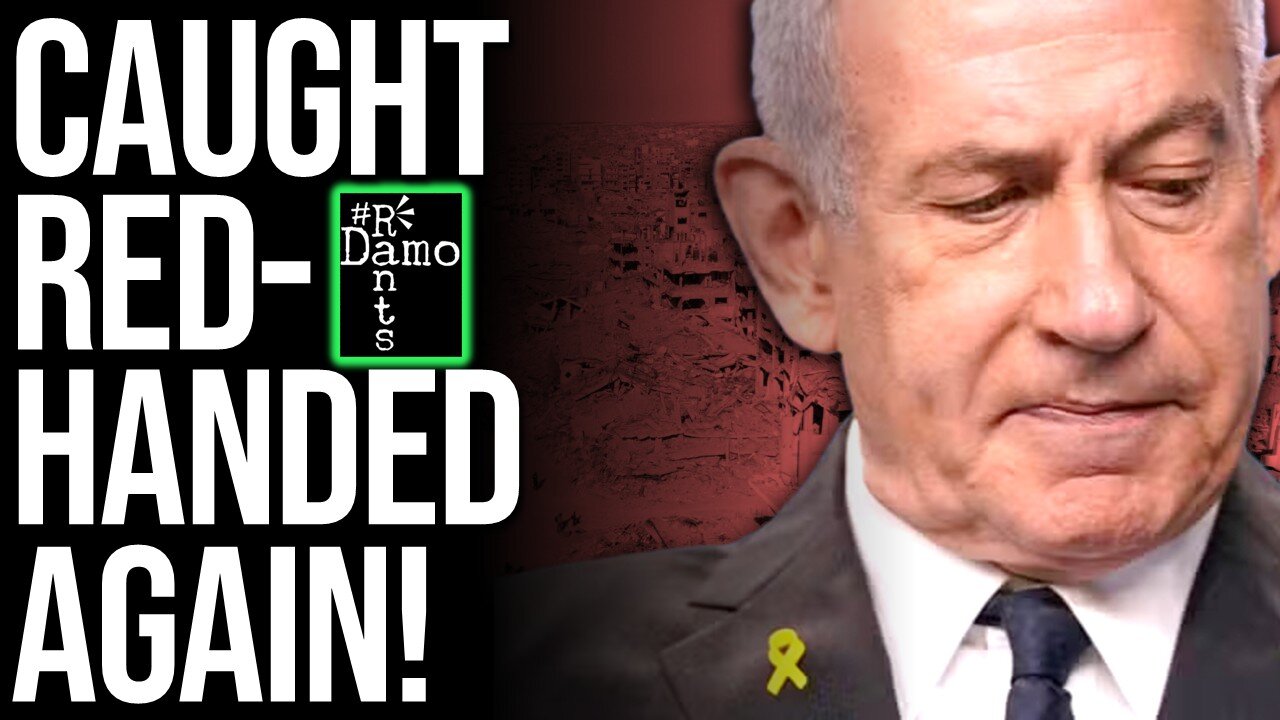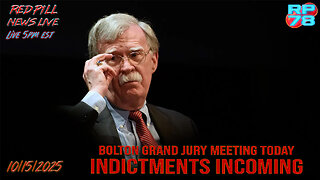Premium Only Content

Netanyahu Found His Way Out of the Ceasefire — And Nobody’s Looking
Right, so Benjamin Netanyahu doesn’t just break ceasefires — he builds them to break. Each one seems to drafted like a booby trap before he’ll assent to it: moral language on the outside, political detonation wired to blow underneath. This latest truce in Gaza is no exception because within hours of signing off on it, Netanyahu is already back to redefining its terms, now demanding Hamas fully disarm before Israel fully withdraws — the diplomatic equivalent of demanding surrender before peace. In point of faxt, he’s making a demand set to be part of phase 2 ceasefire talks, but demanding Hamas do this as part of phase 1. Hamas on the other hand are simply demanding Netanyahu stick to what he’s signed off on now, which in itself would make a change. The people of Gaza, Hamas and non-Hamas alike, have seen this performance too many times to mistake it for peace. They know how fragile the current situation is, but in Netanyahu’s playbook, every ceasefire is a press release with a timer attached, and when it explodes, he’ll call it acting in self-defence yet again. He thinks he’s found a way out again, so we all need to call it out and tell him, we see you.
Right, so the ceasefire that has now taken effect in Gaza, aside from ongoing Israeli strikes, which are becoming fewer at least, shows what a fragile peace we actually have right now. Western broadcasters speak of calm returning to the Strip, of families heading north, of aid trucks edging through checkpoints. The phrase “the truce is holding” is a welcome phrase, but also nods to how easily things could go back the other way, whilst also not saying everything that really should be being said.
In reality, Gaza is a ruin. United Nations field teams report that roughly seventy percent of northern housing stock is destroyed or uninhabitable, so all those people we’re told are returning to their homes, they’re actually returning to where their homes once stood, because they actually have no home to return to. About 1.8 million people — eighty-five percent of the population — remain displaced. The “returns” so often described are little more than pilgrimages to rubble. They are not reclaiming homes; they are locating what is left of them.
Even under ceasefire, Gaza’s Health Ministry recorded nineteen Palestinians killed within the last twenty-four hours. Western outlets neither confirmed nor denied those deaths; they simply omitted them. That silence keeps the fiction alive that quiet equals peace. For those still living amid the dust, the difference frankly right now is largely academic.
Benjamin Netanyahu’s career is built on a rhythm of escalation and pause. Every ceasefire he has endorsed follows the same choreography: sign under pressure, obstruct in practice, invent a breach, resume bombardment.
In 2014, after Operation Protective Edge, Israel agreed to an Egyptian-brokered truce promising reconstruction and limited lifting of the blockade. Within weeks, Netanyahu declared Hamas’s “failure to disarm” a violation — a clause that never existed in the agreement.
In 2021, following Operation Guardian of the Walls, he told Israelis that “quiet will be met with quiet.” Within three weeks, airstrikes resumed on the grounds that Hamas was “testing rockets.”
In 2023, when humanitarian pauses allowed hostage exchanges, Netanyahu told parliament that the war would resume “until Hamas is eliminated.” Each pause was recast as an intermission before the next act.
Across a decade, no ceasefire he has signed has reached completion.
It is his method. His track record on ceasefires confirms his word on such things is worthless.
The 2025 agreement, drafted by the United States with Qatar and Egypt, divides into two phases. Phase One covers the cessation of hostilities, hostage and prisoner exchanges, partial withdrawal of Israeli troops, and unhindered humanitarian entry. Phase Two concerns reconstruction, the creation of a unified Palestinian administration, and the eventual disarmament of resistance groups.
Even Trump’s own twenty-point plan sets this order clearly: disarmament follows the return of hostages and the offer of amnesty. Clause Six specifies that only those Hamas members who decommission weapons after that stage receive safe passage or integration into a legitimate security structure.
Hours after signing though, Netanyahu announced that Hamas must disarm “the easy way or the hard way.” By promoting a second-phase condition into the first, he has already effectively voided the deal whilst appearing to still honour it. This is his play, this is clearly how he thinks he can blow this ceasefire up. That inversion — and his confidence in repeating it — is the mechanism by which every Israeli ceasefire dies.
Hamas have responded publicly and unambiguously. A senior official has said that handing over weapons was “out of the question and not negotiable.” Another representative stated that the organisation would only disarm if its fighters were incorporated into a Palestinian National Army under a Palestinian sovereign state. Whatever you think of Hamas, that formulation echoes the American plan’s second-phase design.
Hamas’ position is therefore not a rejection of peace but a defence of the sequencing: first withdrawal, then political settlement, then disarmament under Palestinian sovereignty. Palestinian factions have since reaffirmed that Gaza’s future government will be determined internally, not by foreign administrators and if we acknowledge the Palestinian state, as many of us do, as increasing numbers of countries now have, surely they have that right to self-determination, predicated on Hamas ceding power, which they have for some time now accepted as a requirement.
International law supports that logic. No occupied population is obliged to disarm while an occupying force remains in place. Doing so would amount to surrender under coercion and would nullify the right to self-defence which is guaranteed by the UN Charter.
Netanyahu’s demand for immediate disarmament was never about enforcing security. It was about creating grounds for accusation. His political history shows a recurring use of linguistic loopholes to justify escalation. In 2014 and again since 2023 it has been tunnels; in 2021 it was balloons, he literally accused Hamas of targeting Israeli jets with incendiary balloons; in 2023 it has also been the use of the “tactical pause.” Each narrative begins with a claim of Hamas non-compliance and ends with the next bombardment. And Western media dutifully carries that narrative.
What makes this pattern harder to disguise now is the physical evidence emerging from Gaza’s ruins. As residents return to what used to be Gaza Humanitarian Foundation distribution centres, they are finding US and Israeli-manufactured ammunition scattered among the debris. These are the same sites where, months earlier, civilians queuing for food were shot at by Israeli forces and American security contractors and it was vehemently denied. Hamas were blamed. Well how did Hamas get US and Israeli munitions? Seems a fair question to ask doesn’t it?
Human Rights Watch has classified those killings as war crimes. Multiple whistle-blowers described the use of live rounds and stun grenades against starving civilians desperate for food. The spent cartridges now being recovered corroborate those testimonies and give the first concrete proof that the “humanitarian zones” were militarised from the start.
This discovery intensifies the pressure on Netanyahu’s narrative though. The aid infrastructure his government hailed as proof of moral restraint now stands as material evidence of criminal conduct. It transforms an allegation into a record. One the ICC and ICJ will gladly accept in their evidence folders.
Television coverage of Gaza’s “reopening” has focused on the sight of families walking north through rubble-strewn streets. Captions call it a homecoming. In truth, they are visiting graveyards of architecture. Infrastructure is gone, roads are impassable, their entire lives have been reduced to rubble.
Field assessments by the United Nations confirm that the material capacity for habitation has collapsed. Those returning do so because displacement camps have become unliveable. Food scarcity remains acute; water is unsafe; hospitals function at minimal levels. Aid might be queuing up to get in, but they need shedloads of it and fast.
UN experts warn that full recovery will take generations, calling the scale of destruction a continuation of the 1948 Nakba. The description fits, its no exaggeration. The demographic pattern — families displaced from the same districts as their ancestors — turns history into repetition by design.
As Gaza still reels from the fallout, Western officials have floated the idea of installing Tony Blair to oversee reconstruction and “governance reform.” The reaction from Palestinian factions was unanimous rejection. Blair’s record in Iraq and his perceived bias during his previous envoy role make his return politically untenable. Besides, what right does another Western figure, especially one as blood-stained as Blair have to rule over Palestine anyway?
Palestinian leaders stated that Gaza’s administration would remain a Palestinian matter. That now surely must be inarguable? Every foreign supervisory project in the past — from the Oslo framework to the Quartet’s oversight — has entrenched Israeli control rather than limited it. Blair’s proposed appointment looked like another attempt to outsource occupation.
That rejection therefore becomes another pillar of internal unity, contradicting the Western narrative of perpetual Palestinian division.
Western news language continues to perform the same sanitising role it has throughout this conflict. Israeli strikes are called “operations,” not attacks. Civilian deaths become “fatalities.” Ceasefire violations are “responses.” Each euphemism reduces accountability and equalises aggressor and victim.
This linguistic neutralisation sustains Netanyahu’s strategy as well. It portrays his manipulations as ambiguities rather than lies. By the time investigations confirm what happened, the political window for outrage has closed. The control of language functions as an extension of the ceasefire’s architecture: flexible for Israel, binding for Gaza.
Inside Israel, maintaining conflict is politically profitable. Netanyahu’s coalition of course relies on far-right partners, the parties of Bezalel Smotrich and Itamar Ben-Gvir whose electoral base equates compromise with weakness and the total end to hostilities as unacceptable. When violence pauses, internal dissent grows and other issues like Netanyahu’s corruption case regain attention. Renewed fighting suppresses both.
Recent polling shows Netanyahu’s approval ratings rise each time he adopts a hard-line stance. A reflection of Israeli society, though that said his ratings are not that great right now as genocide fatigue has very much set in. That feedback loop though means that the longer peace holds, the greater the domestic risk to his leadership. The personal and political incentives to escalate again, blaming it on Hamas, align perfectly.
We should all know by now above all else, that for Netanyahu, peace is not a goal but a liability.
International legal norms require that treaties be implemented in good faith. Yet by signing an agreement and immediately trying to alter its sequence, Israel breaches that principle. United Nations rapporteurs have repeatedly cited its record of non-compliance with humanitarian commitments — from blocking aid convoys to targeting medical facilities.
When viewed together with the newly uncovered munitions evidence, these actions form an even larger pattern of negotiation used as camouflage for continued occupation. The ceasefire becomes a legal instrument for preserving the very conditions it claims to end.
The numbers alone tell the story. Nearly two million displaced. Seventy percent of northern housing destroyed. Chronic famine indicators confirmed by international monitors. Even if restrictions are lifted immediately, rebuilding basic infrastructure is going to take decades.
These facts describe not recovery but controlled deprivation now. Israel retains authority over border crossings, determines which materials may enter, and uses those levers to manage political outcomes. Humanitarian access has become another arm of policy. Every delay or denial functions as coercion.
Netanyahu’s narrative rests on moral inversion. Hamas’s insistence on retaining arms until occupation ends is portrayed as rejectionism; Israel’s refusal to withdraw is described as prudence. This reversal allows the occupying power to claim virtue while enforcing subjugation, never mind the fact it runs counter to the order of the peace plan.
Every ceasefire ends with the same accusation: Hamas is in bad faith. Each accusation conceals Israel’s own violations. The pattern is institutionalised by mainstream media to the point of predictability and I very much doubt I’m the only one thinking in such terms. This ceasefire is going to have to last more than a few weeks for me to start thinking otherwise.
The destruction of Gaza’s infrastructure and the forced movement of its population amount to a demographic transformation echoing 1948. International experts have used the term Second Nakba to capture that continuity. The argument is not rhetorical but evidentiary: systematic displacement, destruction of housing, and obstruction of return meet established legal criteria for the deliberate infliction of destructive living conditions.
In this framework, the ceasefire is less a transition to peace than a pause in an ongoing process of removal.
The United States remains both architect and guarantor of this ceasefire. It drafted the framework, armed one of the parties, and continues to define what counts as compliance. US soldiers are now in place to oversee it, but from who’s point of view? The dual role makes accountability questionable doesn’t it?
For Israel and for Netanyahu, perpetual war becomes a psychological and political necessity. It keeps the electorate mobilised, the opposition marginalised, and the international community perpetually reacting rather than restraining.
Western agencies function as global gatekeepers of verification, while regional outlets — those closest to events — are treated as secondary. When Palestinian sources report casualties, the phrase “unverified” accompanies them; Israeli claims seldom receive that qualifier.
This hierarchy delays recognition of violations and allows official narratives to settle. The GHF killings were first reported by local journalists weeks before Western sources looked at them and even when they did, they took Israeli talking points as fact. By the time those reports were accepted, political focus had shifted. The finding of this ammunition on those sites now, ought to refocus that, but I very much doubt it will.
Yet after two years of this now, the Israeli use of deception is fully visible and in more of our minds. Netanyahu’s government signs agreements under external pressure, manipulates clauses, provokes breaches, and resumes war while blaming the other side. Each stage is predictable.
This ceasefire is already following the same pattern. By demanding disarmament during Phase One, Netanyahu ensures that Hamas’s refusal can later be used as justification for renewed assault. The pretext is built into the blueprint. This is not failure of diplomacy so much as domination by design.
For the first time, however, regardless of media framing, the evidentiary balance is shifting and that matters from the legal standpoint. The munitions recovered from those aid sites, the contradictions between Netanyahu’s statements and the American plan, and the mounting documentation from humanitarian agencies now constitute a record of deceit that Israel cannot evade.
International lawyers and investigative journalists – proper ones - are assembling a paper trail that connects battlefield practice to political instruction. The very language Netanyahu used to justify control — disarmament, security, oversight — is being repurposed as evidence of premeditated manipulation. The pretext machine has started to feed back on its maker.
If this documentation continues to accumulate, Netanyahu may face the first genuine political cost of his ongoing strategy. The walls are closing in as the evidence mounts.
If this ceasefire breaks down as I cannot escape the feeling it will, whether imminent or gradual, will confirm more than the failure of one negotiation though. It will expose a collapse of the diplomatic order itself. When a signatory can alter terms the moment they are signed, and get away with blaming the other side, as has happened too many times before for people to accept that as the truth, then what passes for rules based order loses all meaning.
For Palestinians, the lesson is grimly familiar: justice depends on politics, not law. For their sake I hope I am wrong this time and this peace holds. For the international community, it poses a broader question — whether any peace process led by the same actors that armed the war can ever be legitimate and can ever work and if it doesn’t, what needs to change?
Netanyahu’s ceasefires are not routes to peace, they never work out that way, they always lead back to war. The evidence now available — official documents, public statements, and material proof — demonstrates intent. He signs under pressure, shifts definitions, provokes refusal, and restarts violence. The pattern is deliberate, not accidental.
Every fact supports that conclusion: the two-phase plan, Hamas’s documented compliance with its sequence, the killings during the truce already, the militarised aid zones, the absence of condemnation from allies. Together they reveal a system in which deceit is the governance.
The ceasefire is already being defined by the fragments of ammunition found and who’s it was, the broken aid depots, and the clauses Netanyahu is trying to twist to bring it down again.
He has built a political architecture in which truth is expendable and peace conditional, but every lie leaves a mark. Those marks are now measurable — in satellite imagery, in forensic debris, and in the diplomatic archives of the very governments that shield him.
Until his day of reckoning arrives, every ceasefire signed under his hand will almost certainly carry the same hidden expiry clause: a promise written only to be broken and blamed on someone else.
There are still reasons however to think this ceasefire could be Netanyahu’s undoing regardless of what he does, so many of us are onto him, not to mention those in Israel after all, regardless of mainstream media narratives, so if you’d like a somewhat cheerier look at how this might actually be Netanyahu’s undoing, check out this video recommendation here as your suggested next watch.
Please do also hit like, share and subscribe if you haven’t done so already so as to ensure you don’t miss out on all new daily content as well as spreading the word and helping to support the channel at the same time which is very much appreciated, holding power to account for ordinary working class people and I will hopefully catch you on the next vid. Cheers folks.
-
 LIVE
LIVE
RiftTV
3 hours agoRight Wing Infighting ESCALATES as INSANE Groupchat LEAKS | The Rift | Guest: Braeden Sorbo
452 watching -
 1:02:32
1:02:32
BonginoReport
2 hours agoCORRUPTION FROM THE TOP DOWN! - Nightly Scroll w/ Hayley Caronia (Ep.156)
27.5K16 -
 1:01:21
1:01:21
TheCrucible
2 hours agoThe Extravaganza! EP: 54 with guest co-host Rob Noerr (10/15/25)
44.3K2 -
 3:38:42
3:38:42
MattMorseTV
5 hours ago $106.33 earned🔴Trump's FBI dropped a BOMBSHELL.🔴
125K104 -
 LIVE
LIVE
The Mike Schwartz Show
3 hours agoTHE MIKE SCHWARTZ SHOW Evening Edition 10-15-2025
145 watching -
 1:22:18
1:22:18
Kim Iversen
3 hours agoIsrael VIOLATES Ceasefire Deal | Kamala Says She's Most Qualified EVER
23.7K135 -
 LIVE
LIVE
Quite Frankly
6 hours agoAge-Gating, OpenAI Sexting, Group Chat LEAKS, More | 10/15/25
473 watching -
 LIVE
LIVE
Nikko Ortiz
1 hour agoBattlefield 6 We Blastin... |Rumble Live
122 watching -

Red Pill News
3 hours agoBolton Grand Jury Reviewing Evidence NOW on Red Pill News Live
21.5K11 -
 LIVE
LIVE
Wayne Allyn Root | WAR Zone
7 hours agoWatch LIVE: The War Zone Podcast with Wayne Allyn Root
59 watching